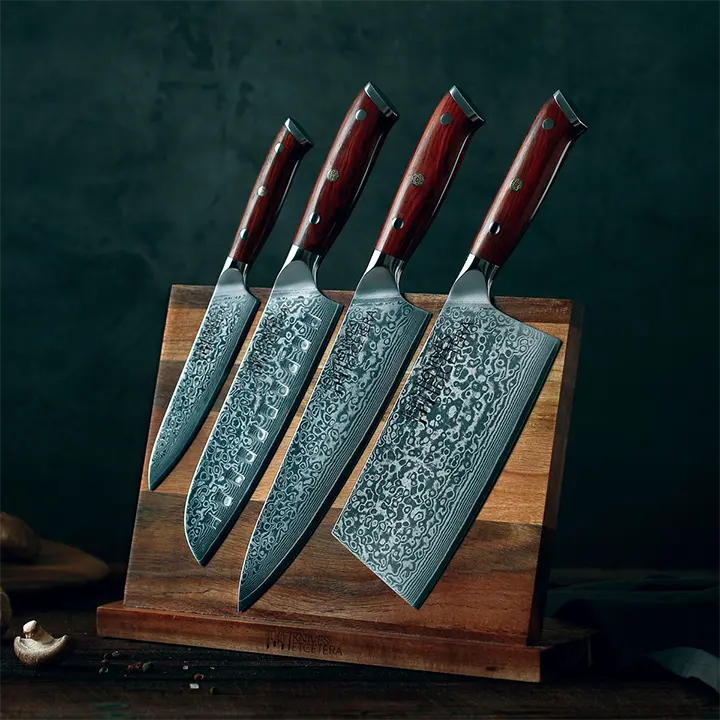
Our top-selling knives.
Damascus steel
kitchen knives.
Our Damascus steel kitchen knives, based on the same crafting principles as the Katana (samurai swords), are the finest on the planet. We’re here to honor the longstanding traditions that these precious blades stem from, bringing them to the enthusiastic cook at an affordable price point.
Shop now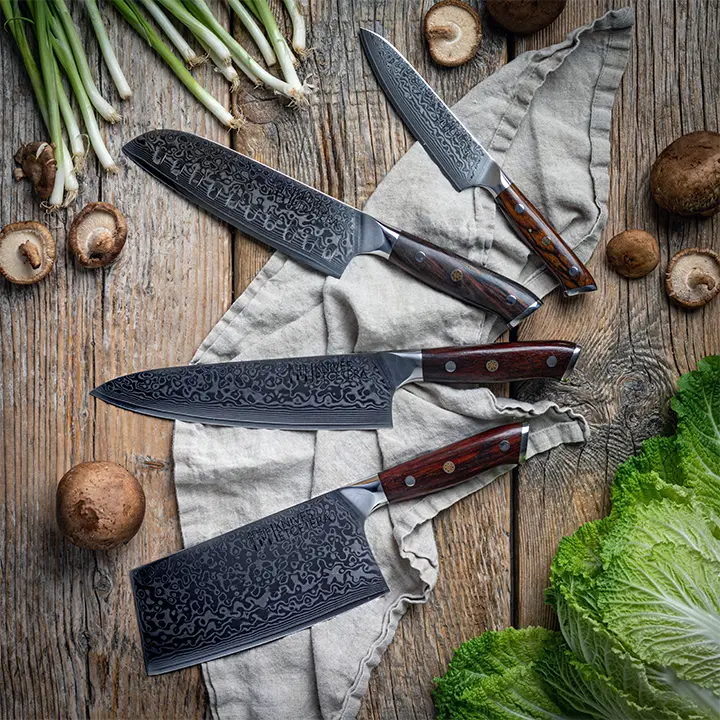
The six kitchen essentials.
One slice can change your life.
Our story began by chance, after stumbling upon a humble chef’s knife while traveling through Japan. After bringing it back to the USA, one slice was all it took to realize that there are levels to cooking, and those who get the most enjoyment from it use the best equipment.
The difference in efficiency and precision was night and day. Fast forward to today and we’re frontrunning the positive shift in cooking standards with unparalleled handcrafted blades.
Are you ready to fall in love with cooking again? It all starts with a slice.
High quality, reliable Damascus kitchen knives.

If you're looking for the best in Damascus steel knives, there's no better place you could look. Knives don't always need to come with a hefty price to deliver the kind of results you want to see in your kitchen.
We offer a host of high-quality Damascus knives to help you handle your business in the kitchen with ease. Our prices are incredibly competitive, thanks to strategic partnerships with our material providers to ensure that we deliver these Damascus blades to our clients affordably.
What our clients are saying.
-

December 25, 2025ExcellentGreat products at extremely competitive prices. Ease of ordering and follow up was very impressive, within 30 minutes of ordering got a dispatch notification and also one from the carrier, products delivered the next day on time exactly when I was told it would be there. Beautifully packaged, ideal for gifting, will certainly be using and recommending in the future.David Cooze -

December 08, 2025Amazing service and fantastic productAmazing service and fantastic productSimon Dixon -

September 30, 2025The service and delivery were quickThe service and delivery were quick. I had I slight problem with my knife when it arrived but I emailed them, they replied within a couple of hours and everything is sorted. So excellent service. And also the knife is very good quality and does the job it was designed for very efficiently.David Fletcher
The Damascus steel design.

When you think of an elite kitchen knife, what comes to mind? Maybe you start thinking about the material, how long the knife is, and even its sharpness. All these factors contribute to either the durability, the cut, or both. Damascus steel knives have been making the rounds for a long time. Here are a few reasons why you should think about picking one up from us.
Damascus steel core with 67 layers.
Note that not every Damascus steel knife has the same composition of layers. The modern style highlighted here boasts 67 layers of Damascus steel. So, you can imagine that your purchase is going to be staying with you for some time. These layers are used to wrap the center, which is akin to a VG-10 Japanese steel core.
These material choices are all rolled into Damascus knives of varying lengths but all with ultra versatile designs. The Japanese inspired steel-like core also has a high carbon design, which makes for an incredibly sharp blade, guaranteeing more precise cuts throughout.
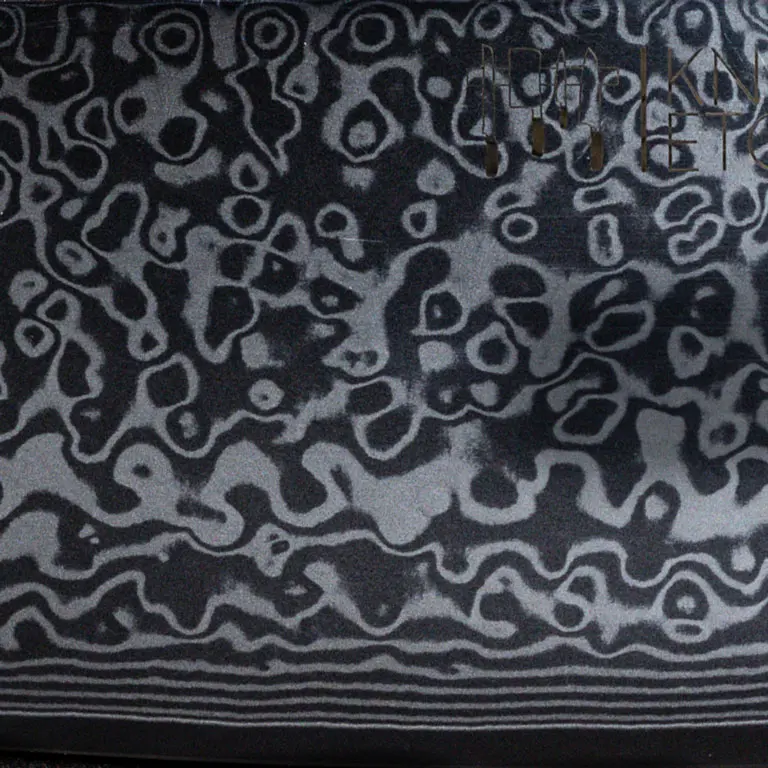
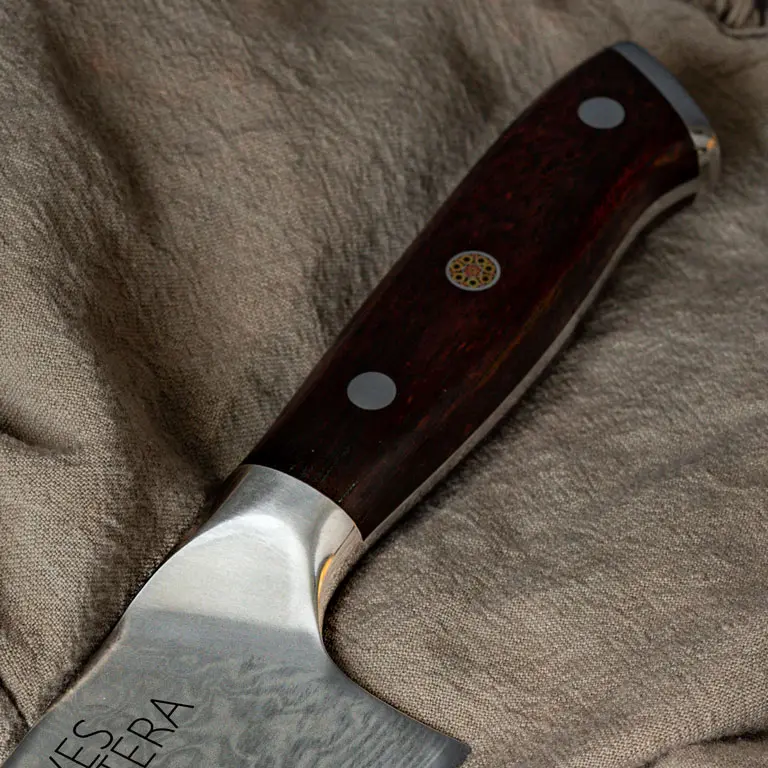
Full-tang handle.
A full-tang design with the blade running throughout the length of the handle offers a better grip and greater durability. Our Damascus steel knives have a beautiful design that uses a single piece of steel running from the tip to the butt.
Additionally, the handle is made of a sturdy material that yields a non-stick grip. The material choices contribute to the weight as much as it does the finish. Feeling it is enough to indicate the quality of the product you're dealing with.
Contemporary design with a beautiful pattern.
A Damascus steel knife is one of the best knives you can get your hands on for the home kitchen. Our catalog guarantees you a wide variety of choices. From the sharp blade edge to the handle, the materials that make up all our knives create a look that brings flair to your kitchen. Imagine automatically looking like a professional by having the layered knife in your hand.
Even though the Damascus design takes advantage of the reliability of the traditional forging, it combines this with modern developments, which are visible in each layer, the sharp cutting edge that prevents food from sticking to the blade, the blade pattern, and even the polished finish.
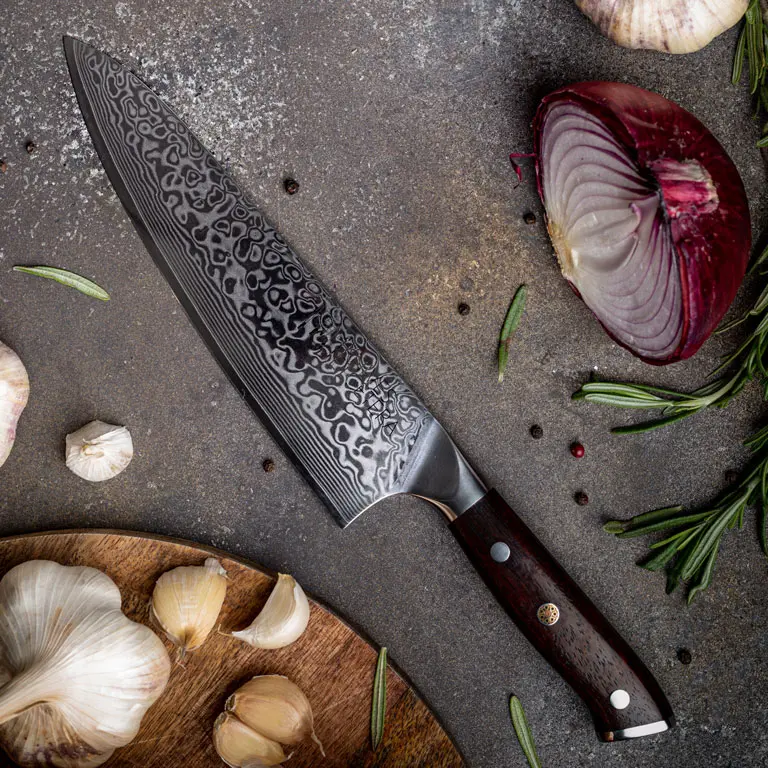
30-day money-back guarantee.
We have tremendous confidence in our Damascus steel knives, which means we are ready to stand behind every layer. Damascus blades are as beautiful as they are hardy and functional, and we believe all customers should be satisfied with their purchases. Therefore, in the unlikely event that you aren't, we allow free returns once you initiate the process within 30 days of your original purchase.
We're not going to have you jump through any hoops either. If you tried your hand at using one of our beautiful, layered Damascus designs and the blade wasn't for you, we ask no questions once the return falls within the required window. So, even if you want to test a full-tang blade to see how the handle and the cut feel, you can go ahead and do so.
The Chef's knife design process.
First, we only use the best materials in our design. Our choices from raw materials to the pattern are inspired by a Japanese design. The crafting process takes place in YangJiang. This Chinese city is known for its stellar design choices where pattern, sharpness, and overall craftsmanship are concerned. You can't argue with almost 1500 years of experience, can you?
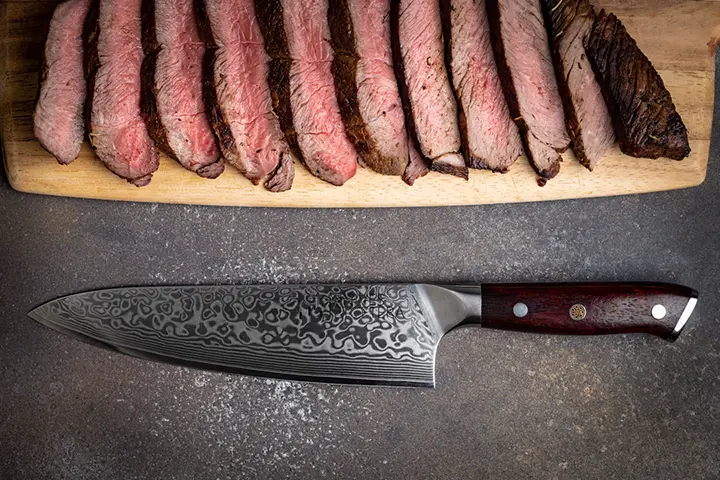
A heat treatment, cold-rolling, and annealing process account for the layered pattern that our set of Damascus knives feature. A hand-polishing and finishing process then follows. In the end, we end up with sharp Damascus steel blades with a comfortable handle and a cutting edge that is the pinnacle of knife design.
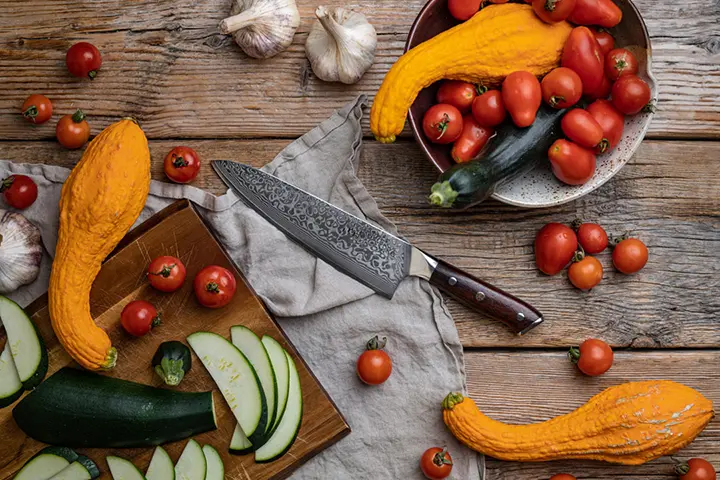
Ironically, one of the reasons you can get such a Damascus knife from us at such an affordable price is the way we chose to handle our manufacturing process. It may be inspired by Japan, but by controlling the manufacturing process we are able to offer a much more affordable option to our valued customers.
The KNIVES ETCETERA® Damascus Chef's Knife difference.
Affordability is one thing, but what else makes a Damascus blade so special? Do you even need one in your kitchen? Well, here are a few things for you to think about:
-
Multi-Purpose Knives
We're not saying you should throw out your full cutlery of blades, but we are saying that our Damascus blade is likely to render them unnecessary. It's hard to dispute the effectiveness of Damascus steel knives.
-
Beginner-friendly
A blade may seem like a simple tool, but you'd be surprised at the difficulty that comes with using some kitchen knives, especially when they're quite sharp. Our quality knives don't fall under that category, as they're just as beginner-friendly as they are conducive to expert use. The professional design makes chopping, slicing, and other cutting methods much simpler to achieve.
-
Favorable Pricing
Razor-sharp Damascus knives such as these often command a high price. The said price for such products often rivals a whole cutlery set, but we believe that quality blades can be much more on the affordable side. If we haven't hammered that point home yet, have a look around our shop. Even if you were to check for Damascus knives on competing sites, you'd be hard-pressed to find similar quality Damascus steel knives for the same kind of price that we're offering here.
Frequently asked questions.
Here's a set of questions that people tend to ask about our beautiful knife offerings. If you have a question before heading to our shop, hopefully, we've provided a satisfactory response here. You can also check out our dedicated FAQ area, as we've responded to a long list of questions from our existing clients.
-
Are Damascus Kitchen Knives Good?
Throughout the design process we keep a close eye to ensure that you are getting a high quality product. We source a set of the best materials from around the world and ensure that we have high quality hammered into the design.
As far as we are concerned, nothing is too hard for us if it means providing the best to our customers. You would be hard-pressed to find a comparable layered Damascus knife for the same kind of price that we are offering.
These knives are amazing and beyond for just about any kitchen application that you may have. The handle is designed with comfort and usability in mind and the edge makes slicing, chopping, and other methods that much easier.
A Damascus blade is one of the best you can get your hands on.
-
Is Damascus Steel the Best for Knives?
While the material is not all it takes to make a good knife, Damascus steel is a reflection of the best. This is especially true when you consider the way the high carbon core resides within a layered design for improved functionality. Of course, we ensure that the aesthetic is complemented by the presence of the pattern.
Do you currently use a series of knives at home or in your restaurant for different tasks? If you want to imagine what Damascus steel can do for you, think of having a single knife that does the job several of the existing ones do. Now imagine that the Damascus knife is even better at doing the said job.
Are You Ready for Functional Excellence?
When it comes to cooking, you always want to ensure that you have the best elements to work with. Sometimes, that means ensuring you have got all the right ingredients to put a meal together. Other times, it means having the right knife at your side.
If you don't have a Damascus steel knife, you're missing out on the advantages that superior craftsmanship can bring to your kitchen needs.
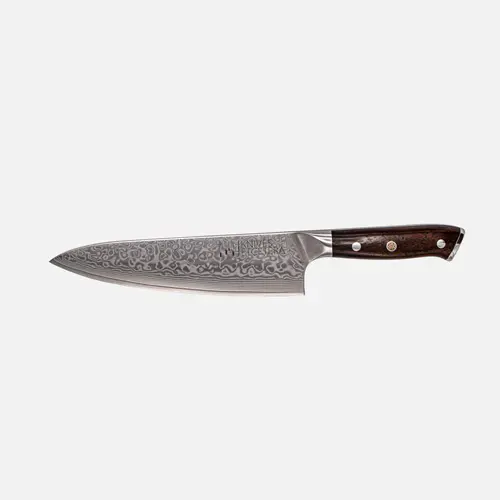 8" Damascus Chef's Knife
8" Damascus Chef's Knife
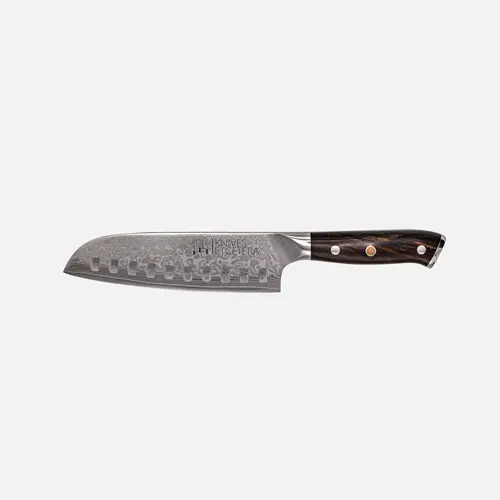 7" Damascus Santoku Knife
7" Damascus Santoku Knife
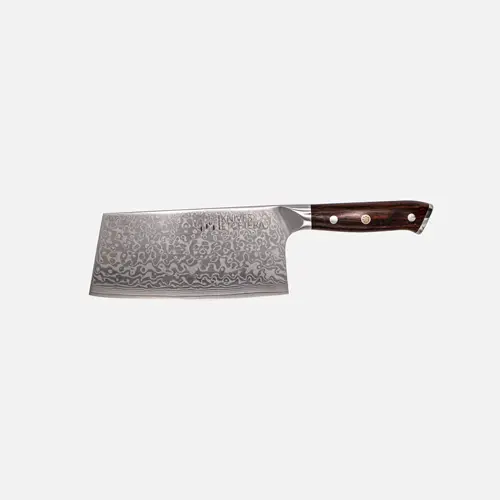 7" Damascus Cleaver Knife
7" Damascus Cleaver Knife
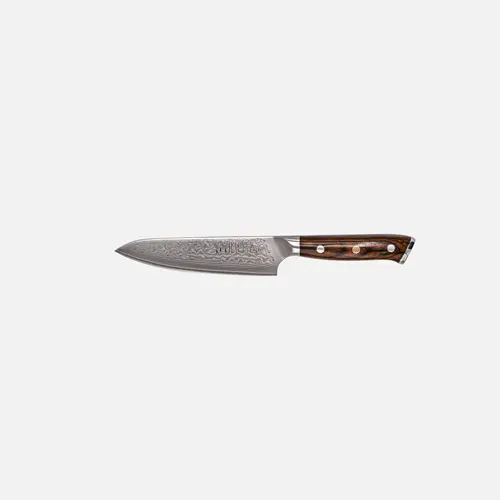 5" Damascus Utility Knife
5" Damascus Utility Knife